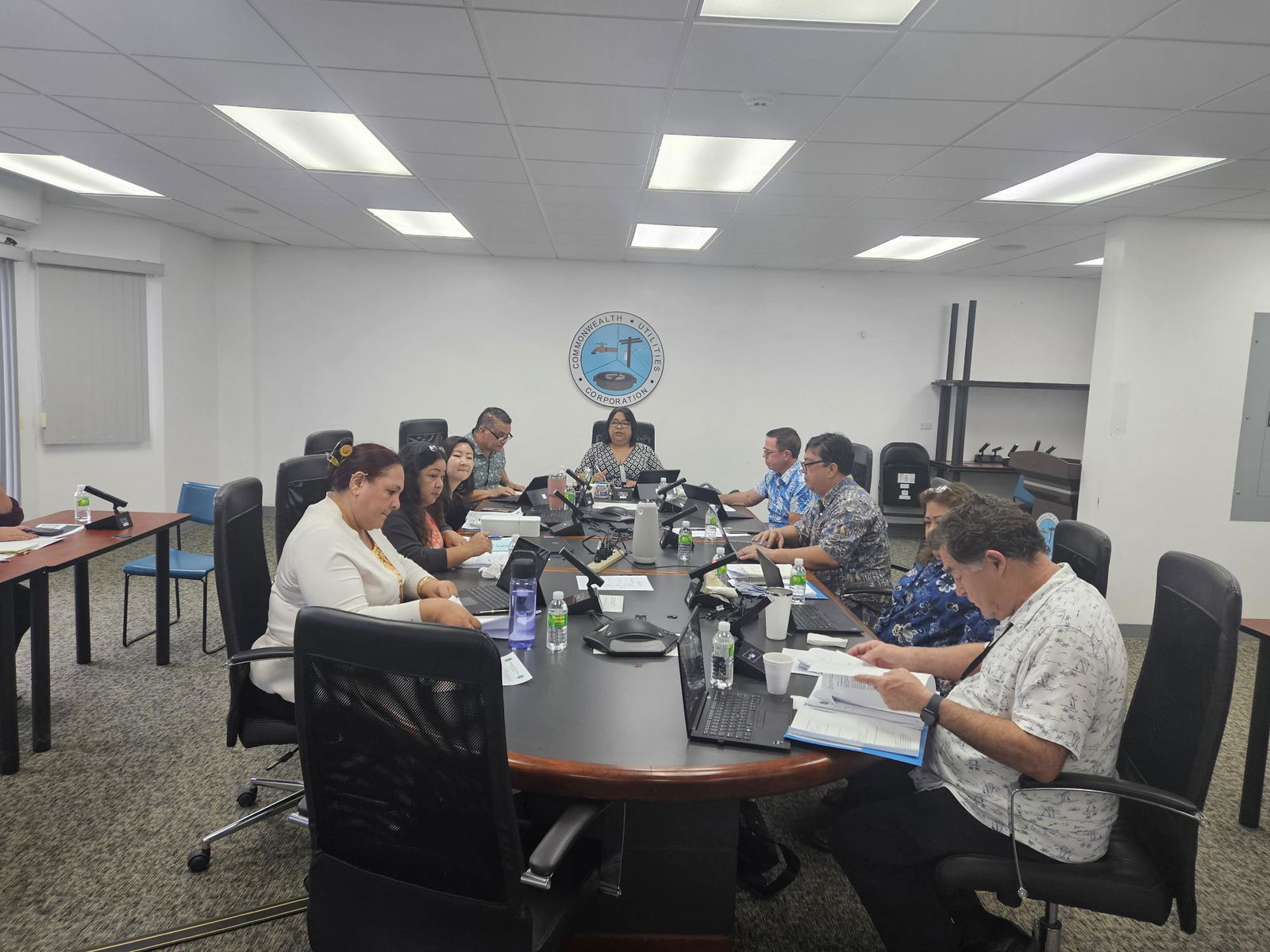
The Commonwealth Utilities Corporation board of directors met on Monday with CUC Executive Director Kevin Watson, and Chief Financial Officer Betty Terlaje.

Commonwealth Utilities Corporation Chief Financial Officer Betty Terlaje, back to the camera, conducts a presentation regarding the Fuel Adjustment Charge during CUC board meeting on Monday morning.
AMONG the elements in the Fuel Adjustment Charge is an allowance for “bad debts,” Commonwealth Utilities Corporation Chief Financial Officer Betty Terlaje said.
“In the FAC rate there’s a small portion, an element called allowance for doubtful account. It’s bad debt basically that takes into account the portion of a bad debt related to fuel. So, in order for our rate to be fully cost recovered, we also need to recover the amount that is not paid,” she told reporters.
“That is a normal cost of business,” Terlaje added. “If you go to a store and buy a can of soda, there are a couple of pennies there from bad debt that the store opens for credit, because they have to,” she said.
“Same with CUC for full cost recovery, we have to recover a portion of fuel that is not recovered. It’s part of the business we have to pay. Who is going to pay for it? It’s going to come out of the FAC rate. The difference here is whether it should be in the fuel rate or non-fuel rate. If it comes out of the base rate, it’s the same thing, it’s still part of the rate.”
She said the board can decide whether or not to include it in the fuel rate.
“But even if I write it off from the books it’s still going to be factored into the non-fuel charges — it’s an expense rate. I understand the concern of the public, saying that they are paying for it, but whether they are paying for it on the fuel rate or non-fuel rate, it’s a business expense that has to be recovered. It will be in the Fuel Adjustment Charge as long as the Commonwealth Public Utilities Commission does not change the rate,” Terlaje added.
She said CPUC may consider changing it now since the “bad debt” element “was put there in 2012.”
At the CUC board of directors regular meeting on Monday, Terlaje made a presentation regarding FAC.
She said the FAC is designed so that ratepayers are neither overcharged nor undercharged for CUC’s actual fuel costs and fuel-related expenses.
“The FAC rate consists of a combination of several elements approved by CPUC. The elements may change upon review and examination of CUC’s data at the next FAC reconciliation, which is [held] every six months,” she added.
As ordered by CPUC, CUC’s fuel adjustment rate was restructured into a Levelized Energy Adjustment Clause or LEAC on Dec. 19, 2008.
On Dec. 10, 2013, CPUC authorized CUC to adjust the LEAC rate up or down if the average fuel price per gallon based on the Mean of Platts of Singapore or MOPS exceeds a 4.5% differential from the previous average fuel price.
On May 11, 2015, CPUC approved renaming LEAC to Fuel Adjustment Charge or FAC.
“Previously, customers did not understand LEAC,” Terlaje said. “In some cases they would allude [to] electrical ‘leaks’ with their bills, [and that] we were charging them for ‘leaks,’ ” she added.
FAC elements
Terlaje said the FAC “is designed to allow CPUC to establish elements … necessary to fully recover fuel and associated costs.”
The FAC is recalculated semi-annually and is subject to CPUC’s approval.
“Every six months … from October to March, and from April to September, we have to submit our data for reconciliation to CPUC for determination of a new rate. In the absence of the CPUC we … have 4.5% authority or automatic adjustments to make the change when the MOPS price changes,” Terlaje said.
Asked by one of the CUC board directors if she can provide the MOPS pricing to the public, Terlaje said, “We cannot share Mobil MOPS prices — they’re proprietary and confidential. We asked before, and they told us they’re proprietary, and we could not share their MOPS prices.”
The Mean of Platts Singapore or MOPS represents the average of a set of Singapore-based oil product price assessments published by Platts, a division of S&P Global.
The current price of SGX Platts Singapore Fuel Oil 380cSt is $384.39 per metric ton.
“Mobil provides us with fuel pricing so that we can define what our fuel rate would be,” Terlaje said.
Mobil is CUC’s only fuel supplier.
The five elements included in the FAC are fuel and lube oil rate, reconciliation rate, volatility rate, regulatory and technical support rate, and allowance for doubtful accounts rate.
The fuel and lube oil rate allows CUC to recover fuel generation lube oil costs and related expenses, such as transportation, taxes, and other costs billed by the supplier.
The reconciliation rate allows CUC to refund any fuel revenue above its actual cost or to recover the amount it billed for fuel.
The volatility rate is an allowance for any variation from the projected fuel prices.
The regulatory and technical support rate recovers projected costs for regulatory fees and expenses and procurement for financial and technical expertise, and helps develop the information, analysis, and reports necessary for the implementation of the FAC.
As for the allowance for doubtful accounts rate, it is the element that recovers the projected bad debt allowance based upon historical performance.
For November 2024, the FAC remains $0.21119 per kWh. CUC said although there has been a slight increase in the average fuel oil prices, the increase did not equal or exceed a 4.5% differential of the average per gallon cost of fuel.
In neighboring Guam, the current LEAC rates are at 26 cents per kWh.











